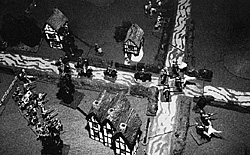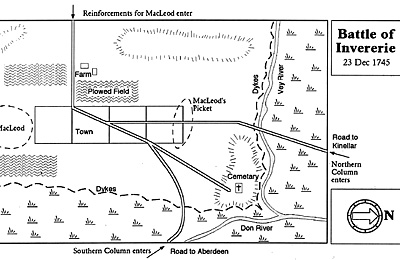
The clash at Inverurie was one of those small engagements that take place in any war that, though small in size, are large in effect.
While Prince Charles led his army back from the ill-fated campaign in England, a number of able officers were left in Scotland to raise men, gather supplies and subdue non-Jacobite clans. One of these able officers was Lord Lewis Gordon. Lord Lewis had orders from the prince to raise men and money in the counties of Aberdeen and Banff and to either bring over or destroy any pro-government clans that threatened to upset those plans.
The town of Aberdeen itself was strongly pro-government and hence a heavy fee was demanded in both men and money. Lord Lewis succeeded in raising a regiment of 2 battalions and established himself at Aberdeen. Meanwhile Aberdeen sent out requests for government assistance to break the Jacobite hold as the town merchants attempted to escape the financial levy. In response, Macleod of Macleod and Munroe of Culcairn, both pro-government clansmen, raised a force to retake Aberdeen for the Hanovarians. They experienced initial success in harassing the Jacobite recruiting and tax collection officers, but things began to go very wrong.
Lord Lewis Gordon wisely ordered his men to stay clear of Grant territory as long as Grant stayed truly neutral. Though he would eventually come out for the government, Ludovick knew that he was caught between a rock and a hard place, his neutrality bought him time. A few of his men snuck off to join Macleod, however.
Munroe and Macleod were undaunted and on the 20th of December, reached the village of Inverurie, about two miles from Aberdeen to set up a base camp for the relief of Aberdeen. The total force consisted of 500 Macleods and 200 Munroes.
Lord Lewis had at his disposal two battalions of 400 men each and three companies of the Irish Brigade of the French Army, recently landed to aid the Jacobites - their strength was about 150, total.
On arriving at Inverurie, Macleod made the fatal error of dividing his force over a two mile front along the banks of the Ury river. There is no apparent reason for this dispersal as Inverurie held enough accommodation for the entire force. In the town itself were 400 Macleods and all the senior officers of the other companies, the remaining forces were scattered in groups of from 25 to 50 in farm houses in the area.
To further upset Macleods security, more reinforcements were arriving from the surrounding countryside for Gordons command, thanks to energetic Jacobite recruiting officers and an active intelligence service that kept Gordon well-informed of Macleods movements.
The Jacobites threw a curtain of patrols around Macleod to keep him from receiving any intelligence, and Macleod seemed unwilling to risk piercing the screen for fear of tipping his enemy to his intentions. Macleods own piquet were even pulled closer in to the main lines after several outposts were captured, to all intents and purposes, Macleod was militarily blind as a bat. One of his officers, however, upon being sent out on patrol attacked, against orders, and drove in every Jacobite piquet post he found. This cleared a good portion of the river front.
The Attack
On the next morning, Gordon assembled his men and marched out of Aberdeen to Inverurie by two roads, one on the north side and one the south side of the river Don. Both groups kept strong advance parties to capture or destroy any enemy patrols they encountered - they found none.
The northern column took a long circular route to approach Macleods flank and halted three miles from Macleods position at the churchyard of Kinellar. there they waited for the other column to come up along the shorter route.
A Jacobite picket surprised a Macleod patrol and captured all but one of them who was able to report the Jacobite approach. Macleod and Culcairn took no immediate action, even neglecting to call in their outlying forces.
Gordon, now with his whole force up, promptly advanced across the Earl of Kintores parks, a quarter mile from the town. Now Macleod acted! He threw some 24 men out as a screen for the ford on the Ury river and he and Culcairn began assembling their men in the town. The bulk of their men were assembled in the SE corner of the town as one of Gordons columns crossed the Don, while the other crossed the Ury. Macleods pickets at the Ury ford were outnumbered and without cutlasses. Armed only with firelocks and bayonets they inflicted several casualties on the advancing column and fell back through town to the main body.
The French were the first across, followed by some 200 new men who had joined a few days before. On crossing the river, the French and their Jacobite allies had to scale several dikes that bordered the village side of the bank. Once across, the Irish pickets formed a line and started a steady advance, firing as they went. Gordon now crossed with his column to attack. Macleods men formed and exchanges 5 or 6 volleys with the French then found Gordons column about to turn their flank.
Culcairn pulled 50 or 60 men to face Gordon but the contest was hopeless. Macleods men however, kept in relatively good order, turning and firing on both assailants as they fell back. Few of them broke ranks and then only when Gordon sent part of his command towards Macleods rear that they started to break up. Sensing victory, Gordon ordered a charge. The sight of the broadsword wielding clansmen at full cry, completed the break. The French advanced steadily into the little village, clearing it street by street. The few diehards died hard but died they did! By now both of Gordon's columns were across the river and extended into line until the village was all but surrounded, only one road being open. This last road was bordered by farmland. In the gathering darkness the furrows in the fields were mistaken as men lying in ambush. Gordon form and fired several volleys into the field before realizing his error, but by then Macleods remnants had escaped. The entire battle from fording the river until the last shots was only 30 minutes long!
The remains of Macleods command regrouped a quarter of a mile off at the village of Ury, then crossed the river Spey later that night. Macleods command was wrecked, having lost its entire baggage train and ammo reserves for 700 men.
Gordon, fearing a night ambush by converging Macleods and Munroes from further up river, did not pursue. He had, however, proven to Prince Charles that his faith in him was well founded.
Though fewer than 2 dozen bodies were left on the field, both French and Jacobites record many wounded being carried from the field during the fighting.
About 30 Macleods were taken prisoner, many joined the Jacobite ranks. Among the prisoners was Macleods own piper, the famed Macgrimman. So respected was he that when taken to Stirling to be imprisoned, all the Jacobite pipers refused to play again until Macgrimman was paroled, which he promptly was. In response to this clemency, Macgrimmin would not play himself until Prince Charles requested it. Such is the joy and sorrow of civil war.
The Terrain
Inverurie makes for such a good game because of the terrain. The town is nestled in the confluence of two small rivers, the Ury and the Don. The rivers form an "L" with the town situated in the elbow. The rivers are bordered on the town side by dikes that extend along the whole front of the town along the rivers. The dikes are of earth and stone construction and add between 3 to 6 feet to the height of the river bank. The slopes of the riverbanks are not steep but would present a formidable obstacle in the icy winter weather in which the campaign was fought.
At the edge of the town a large church and cemetery nestled in the elbow of the two rivers. The cemetery and church was surrounded by a four foot high stone wall. Had this been occupied by, say, a 100 men, it could have covered both roads used by the Gordons for their advance and made things quite hot for them. The town itself is a typical highland coastal village of the time with a few dozen small homes and other buildings such as an inn, blacksmith, etc..
Across from the Jacobite line of approach, the ground is broken by a series of ridges and hills of various lengths and heights. The rivers are fordable in numerous places but at this time of year are about 5 feet deep. At the places where Gordon's men crossed the rivers were about waist deep. It took strong men indeed to cross this in December while wearing only a kilt!!!
The Antagonists
Macleod and Culcairn: 400 Macleods with an additional 300 in small detachments up and down the Ury. The detachments were within 1 1/2 miles of the main party. For the game he can deploy the 400 in the village and outskirts. the 300 reinforcements are off table. Once Macleod had sent for reinforcements, roll 1D10 to determine how many more turns it takes for the reinforcements to arrive on the road behind the village. They must pass an initiative roll of 5 or less to enter, try each turn after first allowed arrival turn until they enter.
To simulate both Macleods and Culcairns inactivity, an initiative roll of a D10 is required for them to act freely (send for reinforcements, re-arrange their commands, etc.). It takes a 9 or 10. Add 1 for each turn after game start. I.e. if it is turn 3, add 3 to the D10 roll and hope to get 9 or 10. On turn 7 it is automatic.
Treat Macleods men as your rules treat any Jacobite unit. Though militia and outnumbered, they did put up one hell of a fight
Lord Lewis Gordon: The first column consisted of the first Btn. of his Rgt and about 1/2 the 2nd Btn. A total of 900 men. The second column consisted of the remainder of Gordons second Btn., The Strathbogie Btn., three 50 man companies of the Irish piquets - one company each from Rgts. Dillon, Ruth, Lally. He also had two naval 4 pound artillery pieces that were not used in the action. The two columns start at the table edge and enter on turn one.
The Rules: This action can be fought with any small unit rules of the period. The author uses Broadsword and Bayonet which are available from The Firing Line, 564 Park Ave., Windsor CT 06095 for $12.00
The Map
This article appears in MagWeb (Magazine Web) on the Internet World Wide Web. Ludovick Grant of Grant, had a force under arms of about 700 men, which Munroe and Macleod attempted to bring into the government ranks. Grant had previously kept his men patrolling their own clan territory following some early raids by the pro-Jacobite MacPheresons and hence was thought to be anti-Jacobite. Grants request for firelocks from the government had been rebuffed. Thus Grant decided against helping defend government interests, as they would not help him protect his lands.
Ludovick Grant of Grant, had a force under arms of about 700 men, which Munroe and Macleod attempted to bring into the government ranks. Grant had previously kept his men patrolling their own clan territory following some early raids by the pro-Jacobite MacPheresons and hence was thought to be anti-Jacobite. Grants request for firelocks from the government had been rebuffed. Thus Grant decided against helping defend government interests, as they would not help him protect his lands.
WARGAMING INVERURIE

Back to Table of Contents -- Courier #70
© Copyright 1996 by The Courier Publishing Company.
Other military history articles and gaming articles are available at http://www.magweb.com